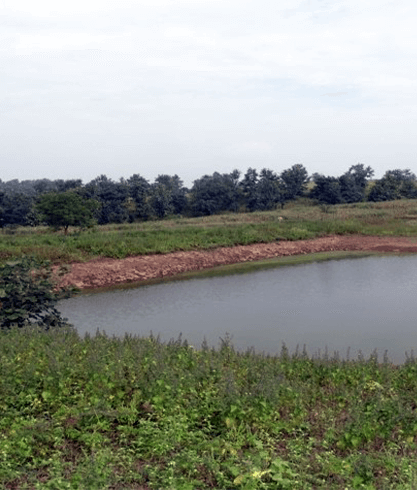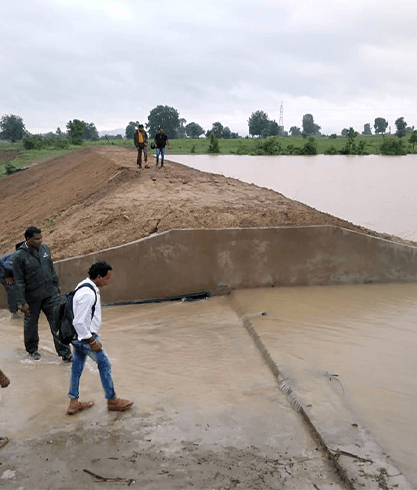
Hindustan Coca-Cola Beverages (HCCB) helping the local tribal farmers of Chicholi and Shahpur blocks in Betul district of MP solve food security and improve livelihood
In the dry highland of 2 blocks covering 38 villages in the Betul district of Madhya Pradesh, the life of around 7900 tribal families no longer looks like a relic of the past age. Marginalised and languished for centuries due to agrarian distress, these poor families of Chicholi and Shahpur blocks are finally beginning to come into their own. The poor farmers who till recently struggled to even feed their family are today investing in their children’s education. And, driving the change in the region is HCCB’s integrated sustainable natural resources development and agricultural initiative. The programme is designed as a Public- Private-Community Partnership between HCCB, Government agencies and the community at large, along with its NGO partner, Action for Social Advancement (ASA). A total of 237 Water Harvesting Structures (WHS) created so far as part of the overall initiative bears testimony to HCCB’s commitment to serve the cause in the community which is around 180 kilometers from its factory near Bhopal. No wonder, this is by far the biggest watershed management project of HCCB.

Legacy of Issues
The story of transformation is unbelievable. The place that has been plagued by uneven distribution of water is today well-positioned to emerge as a harbinger of hope. The crops in the belt would often fail in the near absence of irrigation facilities, and unpredictable monsoon. And, this was a recurring problem that played havoc with farm productivity and crop patterns. Understandably, for the majority of the households, it was a constant battle of survival even for basic human needs. What exacerbated their problem was the lack of access to the market.
Wind of Change
But thankfully, all that is beginning to change. The vast stretch of barren land is fast turning into a green oasis. As such, more land has been covered under irrigation, more tribal have taken to farming and more crops are being produced every season.
And, the reason is simple: water availability in the 2 blocks of Betul district has increased. Sure enough, the farm productivity has improved manifold and this has enabled the local smallholder farmers to sell surplus crops in the market - a great turnaround from the time when they even struggled to feed the family. Believe it or not, all the ponds, dams and other Water Harvesting Structures created in the region are today geo-tagged.
Cattle rearing, another economic activity, is also on the rise in the region. Improvement in crop production coupled with increased income from farms have improved the nutritional level of the local farmers and their family members. Increase in ground water has also improved drinking water availability for humans as well as animals in the region. A happy corollary to the socio-economic improvement in the Betul district is that the community has now started to maintain cleanliness and hygiene in its surroundings.

Seeds of Hope
With the simple ideology of contributing to its community challenges at its heart, HCCB pledged to alleviate the sufferings of these poor farmers. On its part, the company first tried to understand their predicament and develop plans to tide over the prevailing challenges on the ground. It took more than a year for HCCB and ASA to finalise the project before the same was launched in 2015. The idea was not just to apply band-aids but to address the fundamental issues looming large at that point of time.
Initial efforts were meant to effect a step-change in the farm productivity of local farmers. HCCB started the campaign with identification of the potential of rainwater harvesting for recharging the ground water as well as for irrigation in the area. It realised that rainwater harvesting combined with interventions in agri-tech promotions, building local institutional sustainable water capacity, agriculture management and promotion of forward and backward market linkages would bring a positive change in the lives of these indigenous communities.
Expanding the Outreach
Developed meticulously, the Integrated Watershed Management Project was designed with a life cycle of 10 years. The project contained provisions for three other major themes for enhancement of livelihoods of the rural poor. These schemes were Development of Self-Help Groups/ Responsible Producers Group (SHGs/RPGs); Agriculture Productivity Enhancement (APE) and Land and Water Resources Development.
As part of the Agriculture Productivity Enhancement, vegetable cultivation was undertaken with around 1800 farmers in both Shahpur and Chicholi blocks to enhance their livelihoods through vegetable cultivation. Apart from providing technical support, the company also helps arrange inputs such as seeds for the local farmers.
Creation of Self-Help Groups (SHGs) has particularly empowered thousands of local women in Betul to not only improve their livelihood but also earn self-respect in their community. These groups are focused on different activities spanning from savings and access to credit to livelihood development activities. They perform an essential role in realizing the goals of various programs facilitated by HCCB for securing their livelihoods in partnerships with ASA.
HCCB’s initiative to create Farmers Producers Organisation (FPO) in the region in partnership with ASA has made a huge difference in the overall income level of the poor farmers. Registered as ‘Ma Machna Crop Producer Company Ltd, Shahpur’ in 2016, the FPO has been created to provide good quality seeds, fertilizers and other inputs to the cultivators and members and link the farmers to the market through collective action. The FPO’s annual turnover crossed a level of Rs. 3 crore in less than 3 years.
ASA effectively leveraged resources from the Mahatma Gandhi National Rural Employment Guarantee Scheme (MGNREGS) and other government departments for the project.
Building on these initiatives, a number of water harvesting structures such as farm ponds, stop dams, earthen tanks, dug wells, and lift irrigation systems were created for the benefits of the villagers. ASA has also helped create several DOHA, a kind of low-cost water harvesting structure with a view to increasing the availability of water in the region. This is considered ideal for places with undulating terrain and helps in enhancing irrigated croplands.

Snippets of Success
A break-up of the 237 Water Harvesting Structures (WHS) that have been created by HCCB with the help of ASA covering 741 hectares land benefitting 1317 farmers directly and another 5000 farmers indirectly due to increase in water table is as follows –
- 24 Farm ponds were built at the lowest point of a farm to capture runoff water, which is used for irrigation of 22 hectares land of 47 families
- 20 Masonry Stop Dams have been constructed in streams and rivers primarily for water harvesting, Irrigating 185 hectares of land benefitting 403 small holders
- 14 Earthen tanks have been constructed providing minor irrigation in 137 hectares of land of more than 330 small holders while also leading to recharge of nearby dug wells and borewells in the downstream
- 162 dug wells have been constructed in the lower reaches of the watershed for harvesting subsurface recharge, which is used for irrigation 324 hectares of 400 farmers
- 13 DOHA have been built, irrigating 19 hectares land of 26 farmers
Promoting natural resource development, with a special emphasis on sustainable water management and sustainable agriculture, over 5200 families in 38 villages are reaping the benefits of the project, with the natural ecosystem in the area being rejuvenated.
Environmental Impact
The indigenous community in these villages have traditionally grown maize and paddy crops in the Kharif (rainy) season and wheat and gram in Rabi (winter) season. This is in addition to vegetables that they grow in both the seasons and watermelons during summers. However, prior to the commencement of the project, the land that these communities used for cultivation had seen significant deterioration over the years due to natural causes. The incidence of climate change impacting the uneven rainfall causes damage to the crops in the region has also reduced significantly over the years.

Socio-economic Dimension
With this initiative being brought to life, the surrounding land that had been lying idle due to lack of water has been made cultivable. There has been a massive increase in productivity levels and agriculture as a livelihood option has seen a massive uptake. The crop levels have seen unprecedented growth along with an increase in the cropping intensity. Creation of water harvesting structures have seen massive benefits for the farmers, allowing them to grow crops round the year as well as yield better returns on their products. Crops are now watered 2-3 times in a particular season, thus resulting in increase in crop yield. Additionally, with an increase in the groundwater, the local community now has access to drinking water as well.
Most importantly, the family income of the tribal farmers in the region has been improving. An empirical study has revealed that a family provided with irrigation benefits for about an acre of land today earns more than Rs. 50,000 per year incrementally. Adding other benefits of agriculture improvement programme, market linkage, bank credit linkage, the monetary benefit comes to around Rs. 65,000 to Rs. 75,000 per year per family. The farmers also enjoy other social benefits such as membership of SHGs, FPOs, and having a voice in the Gramsabha.
Securing Future
The impact of HCCB’s initiatives can be seen in improved ground water condition and community management systems around water both demand and supply, increased income from agriculture, improved Human Development indices like health, education, housing, etc. and finally, capable community institutions managing local affairs related to natural resources of the area particularly water management. The future of the community looks secured.



Comments